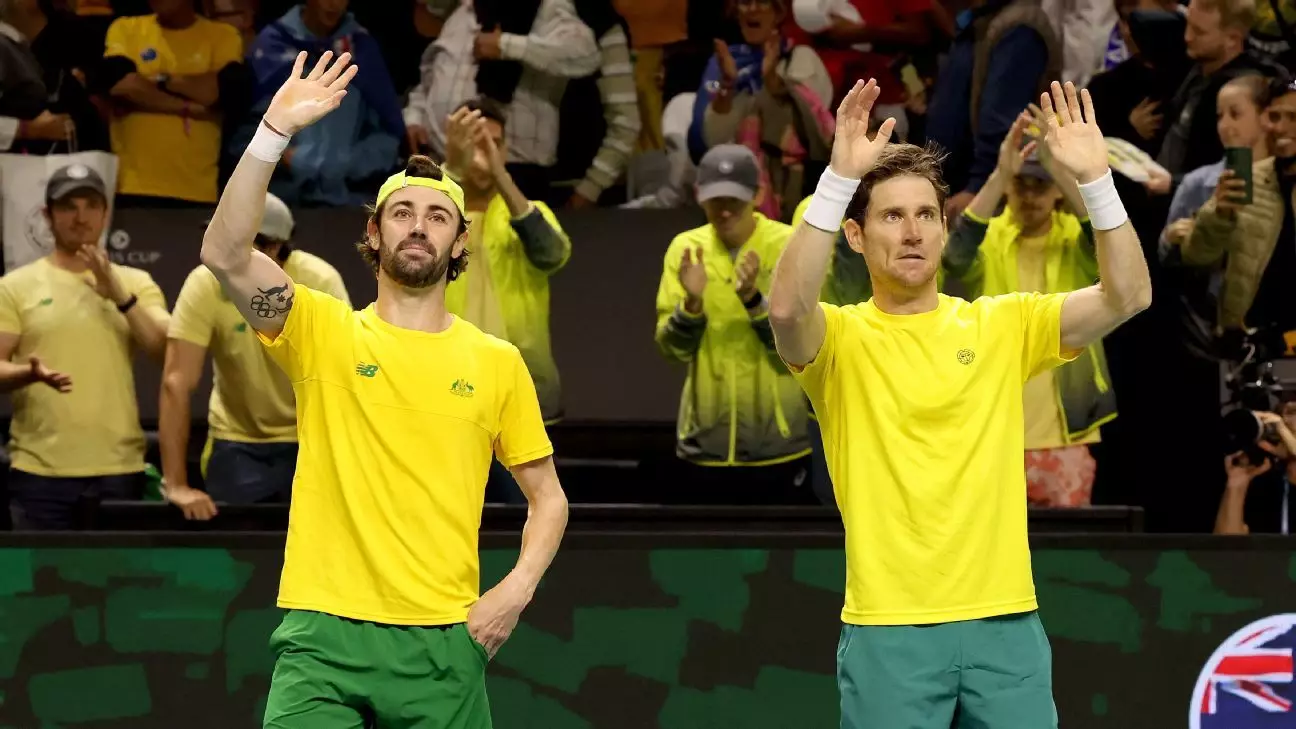In the world of international tennis, few events command the same level of intensity and tradition as the Davis Cup. Competing on behalf of one’s nation infuses the competition with added pressure, underlining the weight each decision bears, especially when it pertains to team composition. Recently, U.S. Davis Cup captain Bob Bryan faced an excruciating decision ahead of a pivotal doubles match in Málaga, Spain. Bryan, whose credentials as a doubles player are impeccable with 16 Grand Slam titles and a prestigious place in the International Tennis Hall of Fame, nevertheless navigated a decision that proved detrimental to the U.S. squad’s aspirations. The outcome of the match against Australia not only resulted in a loss but also deepened a 17-year drought for American Davis Cup titles, raising questions about strategy and foresight.
The match unfolded with the quarterfinals poised at a tense 1-1. Bryan made the unexpected choice to replace the seasoned duo of Austin Krajicek and Rajeev Ram—who recently clinched silver at the Olympics—with singles players Tommy Paul and Ben Shelton. While Bryan aimed to catch the Australians off guard, the switch backfired as Paul and Shelton fell to Matthew Ebden and Jordan Thompson with a score of 6-4, 6-4. The move appeared questionable on many fronts. Krajicek and Ram were not only established in doubles but also showcased a strong synergy built through experience—a vital asset in high-pressure scenarios like the Davis Cup. In stark contrast, Paul and Shelton had limited previous experience playing together, raising eyebrows about the selection.
Understanding the Risks
Upon reflection, one must consider Bryan’s rationale. The hope, as articulated by Bryan, was to leverage a sense of unpredictability to seize an advantage. However, Australian captain Lleyton Hewitt quickly dismissed this tactic, indicating that familiarity with Paul and Shelton’s training regimen rendered the surprise factor ineffective. This instance underscores a crucial aspect of competitive strategy—predictability versus surprise. At what point does the element of surprise yield to the statistically-supported choice of selecting proven players? Bryan’s assertion of having an extensive “world of analytics” at his disposal adds another layer of complexity, suggesting that metrics and player performance are interwoven. However, analytics alone cannot substitute for chemistry and experience in doubles play.
The Davis Cup has historically been a domain where the U.S. has excelled, accumulating a record 32 championships. Yet, the last title, secured in 2007 when Bryan was part of the squad, now feels like a distant memory. This loss signified not merely another match but a continuation of an unsettling trend; since 2018, the U.S. men have not progressed past the semifinals. Such a record raises questions about the broader strategy surrounding American men’s tennis and whether an overreliance on analytics could overshadow the foundational elements of the sport.
Additionally, the performances leading up to the doubles match reveal further complications. Shelton, having just undergone the emotional and physical strain of a singles match that saw him battling through multiple match points, may not have been in optimal condition to pivot into doubles play. Yet, Bryan opted to capitalize on Shelton’s prior rhythm from the day, illustrating the tightrope of coaching decisions.
The recent Davis Cup match serves as a poignant reminder of the complexities surrounding team compositions in high-stakes environments. While Bryan’s decision-making process involved insights gained from practice sessions and discussions with fellow coaches and players, the outcome illustrates that even the most seasoned professionals are susceptible to miscalculations. The future of American tennis may hinge not solely on embracing modern analytics but also on valuing established expertise and teamwork. As Bryan and the U.S. team regroup and analyze this poignant loss, it is imperative to observe how adaptability, strategic insight, and respect for traditional doubles play coalesce in their future pursuits in international tennis.


Napsat komentář